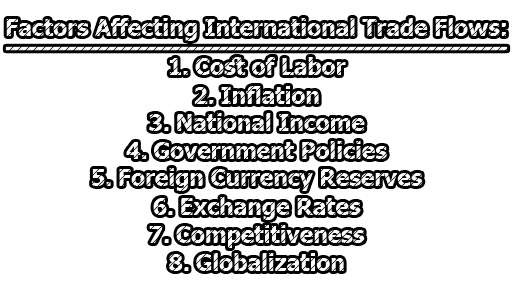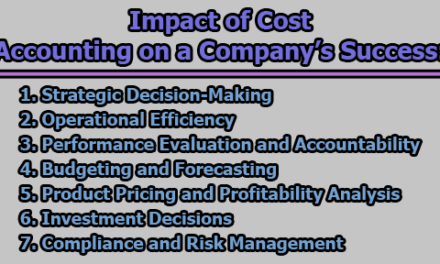International trade is the exchange of commodities, products, services, and capital between people and companies in different countries. International trade has existed for a long time, but trade has increased hugely in the past few hundred years and has had a major impact on the economies of many countries. The difference between total exports and imports is referred to as the balance of trade. A deficit in the balance of trade means that the value of merchandise and services exported by the Government is less than the value of merchandise and services imported by the Government. In the rest of this article, we are going to know about Factors Affecting International Trade Flows, and Difference Between Balance of Trade and Balance of Payments.
Factors Affecting International Trade Flows:
A number of natural, economic, political, and social factors influence international trade. The essential factors affecting international trade flows are listed below:
1. Cost of Labor: Firms in countries where labor costs are low commonly have an advantage when competing globally, especially in labor-intensive industries.
2. Inflation: is the rate at which the general level of prices for goods and services is rising and, consequently, the purchasing power of currency is falling. Inflation is a sustained increase in the general price level of goods and services in an economy over a period of time. When the price level rises, each unit of currency buys fewer goods and services. Consequently, inflation reflects a reduction in the purchasing power per unit of money.
If a country’s inflation rate increases relative to the countries with which it trades, its current account will be expected to decrease. Consumers and corporations in that country will most likely purchase more goods overseas (due to high local inflation), while the country’s exports to other countries will decline.
3. National Income: If a country’s income level (national income) increases by a higher percentage than those of other countries, its current account is expected to decrease. As the real income level (adjusted for inflation) rises reflects an increased demand for foreign goods.
4. Government Policies: A country’s government can have a major effect on its balance of trade due to its policies on subsidizing exporters, restrictions on imports, or lack of enforcement on piracy. Government policies can increase imports through:
- Restrictions on Imports: If a country’s government imposes a tax on imported goods (often referred to as a tariff), the prices of foreign goods to consumers are effectively increased. Tariffs imposed by the U.S. government are on average lower than those imposed by other governments. Some industries, however, are more highly protected by tariffs than others. American apparel products and farm products have historically received more protection against the foreign competition through high tariffs on related imports.
- Subsidies for Exporters: Some governments offer subsidies to their domestic firms so that those firms can produce products at a lower cost than their global competitors. Thus, the demand for the exports produced by those firms is higher as a result of subsidies.
- Lack of Restriction on Piracy: In some cases, a government can affect international trade flows by its lack of restrictions on piracy. In China, piracy is very common; individuals (called pirates) manufacture CDs and DVDs that look almost exactly like the original product produced in the United States and other countries. They sell CDs and DVDs on the street at a price that is lower than the original product. They even sell CDs and DVDs to retail stores. It has been estimated that U.S. producers of film, music, and software lose $2 billion in sales per year due to piracy in China. As a result of piracy, China’s demand for imports is lower. Piracy is one reason why the United States has a large balance-of-trade deficit with China. However, even if piracy were eliminated, the U.S. trade deficit with China would still be large.
- Environmental Restrictions: impose higher costs on local firms, placing them at a global disadvantage compared to firms in other countries that are not subject to the same restrictions.
- Labor Laws: countries with more restrictive laws will incur higher expenses for labor, other factors being equal.
- Business Laws: Firms in countries with more restrictive bribery laws may not be able to compete globally in some situations.
- Tax Breaks: Though not necessarily a subsidy, but still a form of government financial support that might benefit many firms that export products.
- Country Security Laws: Governments may impose certain restrictions when national security is a concern, which can affect trade.
5. Foreign Currency Reserves: To compete effectively in international markets, a nation must have access to imported machinery that enhances productivity, which may be difficult if forex reserves are inadequate.
6. Exchange Rates: The exchange rate is the price of one currency in terms of another. Exchange rates fluctuate depending on the demand for a particular currency. If there is a high demand for a country’s currency then its price will tend to rise. Because currencies fluctuate in price it can often be cheaper to buy goods in one country and sell them in another. Exchange rates consequently have a significant effect on global trade.
7. Competitiveness: In the current environment, with growing interdependence between the markets and in increasing competition, it is more difficult to maintain the current enterprise market position. Competitiveness is a measure of the relative ability of different countries to provide different products or services. Competitiveness takes into account the efficiency, costs of employment, level of government regulation, and ease of doing business. Competitiveness affects international trade because the more competitive countries will tend to attain a higher level of global trade.
8. Globalization: Globalization is the term used to describe a general tendency for national economies to become more integrated with each other. This happens because of a combination of advanced communication technologies, logistic technologies, increased capital flows, and reduction of trade barriers by national governments.
Difference between Balance of Trade and Balance of Payments:
| Balance of Trade | Balance of Payments |
| The net balance of products exported and imported within a specific time period is known as the balance of trade. | The total accounting of all economic transactions between a nation and the rest of the globe is known as the balance of payments. |
| A country can determine its net profit or loss from exporting and importing products using the balance of trade. | The payment balance makes it possible to verify that everything has been correctly accounted for. |
| The difference between items exported and imported makes up the trade balance. | The difference between the inflow and outflow of foreign currency is known as the balance of payments. |
| The balance of trade has a net effect that might be positive, negative, or zero. | The balance of payments always has zero net effect. |
| It can be Favorable, Unfavorable, or balanced. | Both the receipts and payment sides’ tallies. |
| Merchandise-related entries can be found in the balance of trade. | The balance of payments includes all transactions including commodities, services, and transfers. |
| The trade balance excludes capital transfers and unilateral transfers. | The balance of payments includes capital and unilateral transfers. |
| Transactions are related to goods only. | Transactions related to both goods and services are recorded. |
| It provides a partial view of the country’s economic status. | It provides a clear view of the economic position of the country. |
Finally, we can say that International Trade has been an area of interest to economists and policymakers. Its importance and essence center on the ability and willingness to obtain and secure goods that cannot be manufactured in the Nation or that can solely be manufactured at much or greater expenses. It enables and allows a Country to sell its domestically manufactured products or commodities to other Nations of the globe. However, conceptualizing and knowing how to calculate the balance of trade and payments will allow you to understand foreign exchange policies quite well.
References:
- James T. (2014). Factors influencing international trade. Access on http://www.ehow.com/info_8210281_factors-influencinginternational-trade.html
- Svarova, M., Vrchota, J. (2014). Influence of Competitive Advantage on Formulation Business Strategy. In Procesia Economics and Finance, vol. 12, p. 687-694
- Adeleke, M. K., Olowe, O. S. &Fasesin, O. O. (2014). Impact and Effect of Foreign Direct Investment (FDI) on economic growth of Nigeria, International Journal of Academic Research in Business and Social Sciences, 4 (8), 236-244

Assistant Teacher at Zinzira Pir Mohammad Pilot School and College










